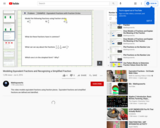
This video models equivalent fractions using fraction pieces. Equivalent fractions and simplified fractions are defined and identified.
- Subject:
- Mathematics
- Material Type:
- Lecture Notes
- Lesson
- Date Added:
- 04/20/2021

This video models equivalent fractions using fraction pieces. Equivalent fractions and simplified fractions are defined and identified.
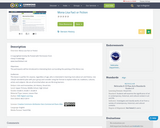
Mona Lisa Fact or FictionA Copyrighted Activity Re-Posted with Permission from Cheryl Trowbridgewww.teachkidsart.netObjectives:The participants will be introduced to interesting facts surrounding the painting of the Mona LisaAudiences: This lesson is perfect for anyone, regardless of age, who is interested in learning more about art and history. Use Cheryl’s wonderful plan with your group and consider using her format to explore other art, traditions, cultures, artists and subjects. We are all enriched when we are life-long learners.

Monroe brought a vision of an expanded America to his presidency"”a vision that helped facilitate the formulation of what has become known as the Monroe Doctrine. In this unit, students will review the Monroe Doctrine against a background of United States foreign relations in the early years of the republic.
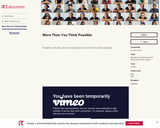
Students in EL Education schools achieve more than they think possible.

After reading “The Most Dangerous Game” students will comb through the text to pull out the best examples of imagery from the story. They will work together in groups of three to collect five examples (per person) of imagery. Students must be able to see each other’s examples, so they don’t repeat them, but also help each other identify which imagery is being documented.
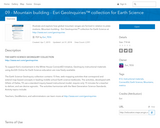
This activity illustrates how global mountain ranges are formed related to plate motions.
GeoInquiries are designed to be fast and easy-to-use instructional resources that incorporate advanced web mapping technology. Each 15-minute activity in a collection is intended to be presented by the instructor from a single computer/projector classroom arrangement. No installation, fees, or logins are necessary to use these materials and software.
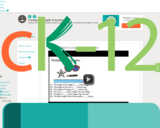
Compare different objects for measurement
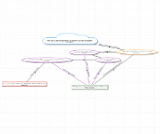
This roadmap addresses 3.OA.6. Multiplication and Division Relationships.
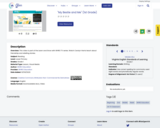
This video is part of the Learn and Grow with WHRO TV series. Watch Carolyn Harris teach about friendship and retelling stories.
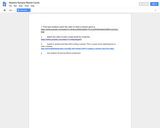
For this lesson, students will learn how to write a mystery. They will be given a list of Nursery Rhymes and asked to create a mystery from the Nursery Rhyme. For example, Did Humpty Dumpty really fall off the wall or was he pushed? They will create a comic from their mystery.
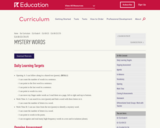
Opening A: I can follow along in a shared text (poem). (RF.K.1)
I can count the number of words in a sentence.
I can point to the first word in a sentence.
I can point to the last word in a sentence.
I can point to words in a text.
I can move my finger under words as I read them on a page, left to right and top to bottom.
Work Time A: I can search in a text (poem) and find a word with three letters in it.
I can count the number of letters in a word.
Work Time B: I can use clues from the text (poem) to identify a mystery word.
I can count the number of letters in a word.
I can point to words in the poem.
I can recognize and read many high-frequency words in a text and in isolation (alone).

Opening A: I can follow along in a shared text (poem). (RF.K.1)
I can count the number of words in a sentence.
I can point to the first word in a sentence.
I can point to the last word in a sentence.
I can point to words in a text.
I can move my finger under words as I read them on a page, left to right and top to bottom.
Work Time A: I can search in a text (poem) and find a word with two letters and three letters in it.
I can count the number of letters in a word.
Work Time B: I can use clues from the text (poem) to identify a mystery word.
I can count the number of letters in a word.
I can point to words in the poem.
I can recognize and read many high-frequency words in a text and in isolation (alone).
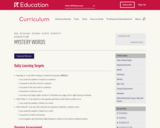
Opening A: I can follow along in a shared text (poem). (RF.K.1)
I can count the number of words in a sentence.
I can point to the first word in a sentence.
I can point to the last word in a sentence.
I can point to words in a text.
I can move my finger under words as I read them on a page, left to right and top to bottom.
Work Time A: I can search in a text (poem) and find a word with two letters in it.
I can count the number of letters in a word.
Work Time B: I can use clues from the text (poem) to identify a mystery word.
I can count the number of letters in a word.
I can point to words in the poem.
I can recognize and read many high-frequency words in a text and in isolation (alone).

The NAACP fights to establish anti-lynching laws in the years between the World Wars
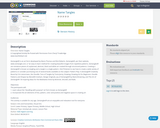
Name TanglesA Copyrighted Activity Re-Posted with Permission from Cheryl Trowbridgewww.teachkidsart.netZentangle® is an art form developed by Maria Thomas and Rick Roberts. Zentangle®, per their website, www.zentangle.com, is “an easy to learn method for creating beautiful images from repetitive patterns. Zentangles® are miniature pieces of unplanned, abstract, black and white art created through structured patterns. Creating a Zentangle® is known as tangling and a tangle is a single pattern. Visit Pinterest to see how to create a wide variety of patterns or consider purchasing one of several books available on the subject: Pattern Play: A Zentangle® Creativity Boost by Cris Letourneau, Zen Doodle: Tons of Tangles by Tonia Jenny, Drawing: Drawing Art for Beginners: Doodle Patterns and Shapes by Meredith Graham, Design Originals, Joy of Zentangle® by Marie Browning, and The Art of Zentangle®: 50 Inspiring Ideas for the Meditative Artist by Bremner, Brunell, and Raile. Objectives:The participants will:1. Learn about the “doodling with purpose” art form known as Zentangle®2. Incorporate the art elements of line, pattern, color and positive and negative space in creating artAudiences:This activity is suitable for any age. Zentangles® are an enjoyable and relaxation tool for everyone.
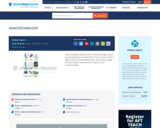
Lesson looking at different uses of nanotechnology. Lesson activity depicted on the PowerPoint. The sunscreen article is higher level; providing differentiation. Nanoscale and web link help students understand the relative size of nanotechnology.
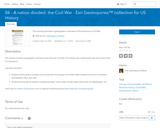
This activity provides a geographic overview of the American Civil War.
GeoInquiries are designed to be fast and easy-to-use instructional resources that incorporate advanced web mapping technology. Each 15-minute activity in a collection is intended to be presented by the instructor from a single computer/projector classroom arrangement. No installation, fees, or logins are necessary to use these materials and software.

The National Gallery of Art in Washington, D.C. has an extensive section devoted to educational resources for both educators and students. One example is a pdf or online accessed text on the Dutch Golden Age. This is comprehensive in both history and art objects and is clearly written. There are more images than text, but the sections that are included are instructive. Other topics include the Italian Renaissance, Art since 1950, a module on Arts and Crafts, American Art since the colonial period, etc. Some material is geared toward younger learners, but much of it is appropriate for an introductory, or even next level, art history class. There is no licensing statement, although it is copyrighted. There are teacher resources available as well including assessments and images. Individual teaching packets come with 20 slides, 12 11 x 14 reproductions, a cd with jpgs, and a separate classroom activity guide.
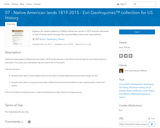
Explore the spatial patterns of Native American lands in 1819 and the decrease in size of those lands through the current Native American reservations.
GeoInquiries are designed to be fast and easy-to-use instructional resources that incorporate advanced web mapping technology. Each 15-minute activity in a collection is intended to be presented by the instructor from a single computer/projector classroom arrangement. No installation, fees, or logins are necessary to use these materials and software.
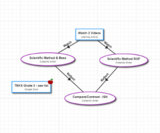
In this Roadmap, students will learn about the scientific method.